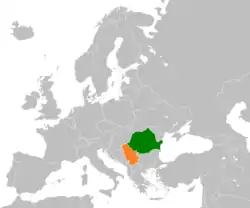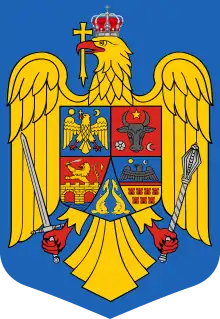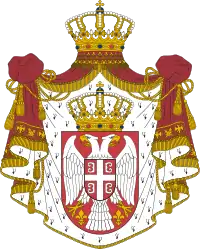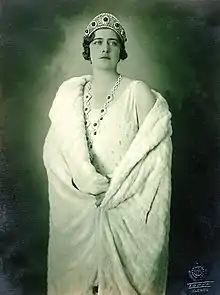Romania–Serbia relations
Romanian–Serbian relations are foreign relations between Romania and Serbia. Both countries established diplomatic relations on April 19, 1841.
 | |
Romania |
Serbia |
|---|---|
Country comparison
| Coat of arms |  |
 |
| Population | 19,317,984 | 7,120,666 |
| Area | 238,397 km2 (92,046 sq mi) | 88,361 km2 (34,116 sq mi) |
| Population density | 84.4/km2 (218.6/sq mi) | 144.46/km2 (330/sq mi) |
| Capital | Bucharest | Belgrade |
| Largest city | Bucharest – 1,883,425 (2,315,173 Metro) | Belgrade – 1,640,000 (2,000,000 Metro) |
| Government | Unitary semi-presidential constitutional republic | Unitary parliamentary constitutional republic |
| Current Leader | President Klaus Iohannis Prime Minister Ludovic Orban |
President Aleksandar Vučić Prime Minister Ana Brnabić |
| Official languages | Romanian | Serbian (official provincial languages: Slovak, Hungarian, Romanian, Rusyn, Croatian) |
| Main religions | 86.45% Romanian Orthodoxy, 7.15% Protestantism, 5.41% Catholicism, 0.78% other, 0.21% Irreligion/Atheism |
84.1% Eastern Orthodoxy, 6.24% Roman Catholicism, 3.62% Islam, 2% Protestantism, 5.4% other |
| Ethnic groups | 88.92% Romanians, 6.50% Hungarians, 3.29% Romani, 1.29% other |
83% Serbs, 4% Hungarians, 2% Bosniaks, 1.5% Romani, 1% Yugoslavs, 1% Slovaks, 10% other |
| GDP (nominal) | US$261.868 billion ($13,414 per capita) | US$50.061 billion ($6,781 per capita) |
History


Although Serbia unofficially opened a kind of diplomatic agency in Bucharest in March 1836,[1] officially, the first Serbian diplomatic agency in Bucharest was established in February 1863, with Kosta Magazinović, as its first diplomatic agent. Reciprocally the first Romanian diplomatic agency in Belgrade was established on 12/24 March 1863 and the first diplomatic agent was Teodor Calimachi.[2]
In 1879, as a consequence of the independent state status, the diplomatic agencies from Belgrade and Bucharest became legations and the diplomatic agents, resident ministers. Thus on 14/26 April 1879 the Romanian diplomatic agency in Belgrade became legation, having Lascăr Catargiu as its first resident minister.[3] In the summer of 1879 Milan A. Petronijević became Serbia's first resident minister in Romania.[4] Later, after Romania and Serbia became kingdoms, in 1881 and 1882, their diplomatic representatives became "extraordinary envoy and plenipotentiary ministers". It was only in 1939 when the legations from Belgrade and Bucharest became embassies.
However, a gradual cut-off of international relations between Romania and Serbia (in that time Yugoslavia) happened in May 1941, after Romania recognized the independence of the German-controlled Independent State of Croatia, due to Romania still being in the Axis in that time.
Embassies

Romania has an embassy in Belgrade and a consulate-general in Vršac. Serbia has an embassy in Bucharest and a consulate-general in Timișoara.
Common memberships
Both countries are full members of the South-East European Cooperation Process, of the Stability Pact for South Eastern Europe, of the Central European Initiative, of the Southeast European Cooperative Initiative and of the Organization of the Black Sea Economic Cooperation. Also Romania is an EU member and Serbia is an EU candidate. Both countries are strongly against 2008 Kosovo declaration of independence. Romania has strongly supported Serbia's territorial integrity.
Serbs of Romania
The Serbs of Romania are a recognized ethnic minority. According to the 2011 census, there were 18,076 Serbs in Romania (~0.1%). Serbs mostly live in western Romania, in the Romanian part of the Banat region, where they constitute an absolute majority in two communes and a relative majority in one other.
Romanians of Serbia
The Romanians of Serbia are a recognized ethnic minority. According to the 2011 census, there were 29,332 Romanians in Serbia (~0.4%), while 35,330 people declared themselves Vlachs. There are differing views among some of the Vlachs over whether or not they should be regarded as Romanians or as members of a distinctive nationality. Romanians and Vlachs of Serbia mostly live in northeastern Serbia in the Timok Valley and in the Serbian part of the Banat region, where they constitute a minority in two municipalities and in Vojvodina. Vlachs of the Timok Valley have no schools in maternal language.
See also
References
- Reprezentanțele diplomatice ale României, vol. I, 1859–1917, București, 1967, pp. 130–134.
- G.G. Florescu, "Agențiile diplomatice de la București și Belgrad (1863–1866)", în Romanoslavica XI/1965, pp. 126–131.
- A. A. Căpușan, Diplomați români de elită, vol. II, ediția a II-a, București, 2009, p. 13.
- Bogdan Catana, Relații diplomatice româno-sârbe, 1880–1913, Craiova, 2009, p. 74.
Further reading
- Isailović, Neven G.; Krstić, Aleksandar R. (2015). "Serbian Language and Cyrillic Script as a Means of Diplomatic Literacy in South Eastern Europe in 15th and 16th Centuries". Literacy Experiences concerning Medieval and Early Modern Transylvania. Cluj-Napoca: George Bariţiu Institute of History. pp. 185–195.CS1 maint: ref=harv (link)
- Ivić, Pavle, ed. (1995). The History of Serbian Culture. Edgware: Porthill Publishers.CS1 maint: ref=harv (link)
- Mitrović, Andrej (1969). Jugoslavija na Konferenciji mira 1919-1920. Beograd: Zavod za izdavanje udžbenika.CS1 maint: ref=harv (link)
- Mitrović, Andrej (1975). Razgraničenje Jugoslavije sa Mađarskom i Rumunijom 1919-1920: Prilog proučavanju jugoslovenske politike na Konferenciji mira u Parizu. Novi Sad: Institut za izučavanje istorije Vojvodine.CS1 maint: ref=harv (link)
- Pilat, Liviu (2010). "Mitropolitul Maxim Brancovici, Bogdan al III-lea şi legăturile Moldovei cu Biserica sârbă". Analele Putnei (in Romanian). 6 (1): 229–238.CS1 maint: ref=harv (link)
- Sorescu-Marinković, Annemarie (2010). "Serbian Language Acquisition in Communist Romania" (PDF). Balcanica. 41: 7–31.CS1 maint: ref=harv (link)
- Stojkovski, Boris; Ivanić, Ivana; Spăriosu, Laura (2018). "Serbian-Romanian Relations in the Middle Ages until the Ottoman Conquest" (PDF). Transylvanian Review. 27 (2): 217–229.CS1 maint: ref=harv (link)
